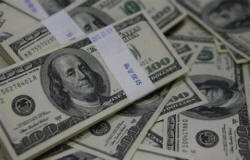|
 Yen
on verge of breakout after U.S. yields slide Yen
on verge of breakout after U.S. yields slide
 Send a link to a friend
Send a link to a friend
[May 19, 2014] By
Patrick Graham
LONDON (Reuters)
— The
dollar struggled to hold an important support level
against the yen on Monday, hit by a fall-off in
expectations for higher U.S. interest rates, while the
pound faced pressure from signs a major merger deal will
fail.
|
|
 Were the yen to drop below 101.20 yen per dollar, it would be the
first time since November of last year that it has traded stronger
than its 200-day moving average and in nominal terms the strongest
since early February. Were the yen to drop below 101.20 yen per dollar, it would be the
first time since November of last year that it has traded stronger
than its 200-day moving average and in nominal terms the strongest
since early February.
That reflects both a dip in U.S. treasury yields in the past week
and the dollar's broader problems with delivering the strength many
had expected of it this year.
At the start of European trading the yen changed hands at its
strongest in two months at 101.24 yen before retreating a touch.
"My sense is that we will push through 101.20," said Alvin Tann, a
currency strategist with Societe Generale in London.
"The chief reason is the slide in U.S. 10-year yields - I think
dollar yen will follow that move and wouldn't be surprised if we got
down to levels of 100 to 100.5."

It has been a choppy couple of weeks for major currency markets,
hamstrung this year by a lack of clear differentiation between the
respective economic stories of Japan, Europe and the United States.
While growth is now moving at different rates, interest rates in all
three remain rooted to rock bottom, although signs the European
Central Bank is preparing further measures to loosen monetary
conditions knocked the euro back last week.
The single currency gained 0.2 percent on Monday to $1.3717 after a
volatile session on Friday.
Analysts from Credit Agricole said that the euro's resistance to
further losses at the end of last week raised prospects it may head
higher.
"This week's focus will be on PMI releases, which we expect to
confirm a trend of further improving growth conditions," they said
in a morning note.
"Under such conditions, position squaring-related EUR upside cannot
be excluded. We advise against selling the single currency around
the current levels. From a broader angle, however, we expect rallies
to remain a sell."
PFIZER BLOW
Merger activity around a handful of Britain's biggest companies has
been one factor helping sterling this year, and dealers said
AstraZeneca's rejection of Pfizer's latest bid may put some pressure
on the UK currency.
[to top of second column] |

"There are people talking about sales of the pound after this news,"
said one London-based currency dealer. "I don't know if that's
because Pfizer had genuinely done some of this business or just
because some people had been betting on it, but it would be a
disappointment."
The pound, one of this year's better performers among the majors
thanks to an improving economy, was a touch lower to the euro in
early trade but largely unchanged against the dollar.
Investors also await minutes later this week of the Federal
Reserve's April 29-30 policy meeting, as well as a private survey on
China's manufacturing sector for May.
The dollar index stood at 79.98, down slightly on the day after
notching up a modest 0.2 percent gain last week, when it touched a
six-week peak of 80.338 on Thursday.
Commodity currencies were sluggish as well with the Australian
dollar just a touch lower at $0.9356 following a flat week. Traders
said the 94 U.S. cent level is still providing a cap for the Aussie
for now.
(Editing by John Stonestreet)
[© 2014 Thomson Reuters. All rights
reserved.] Copyright 2014 Reuters. All rights reserved. This material may not be published,
broadcast, rewritten or redistributed.

 |